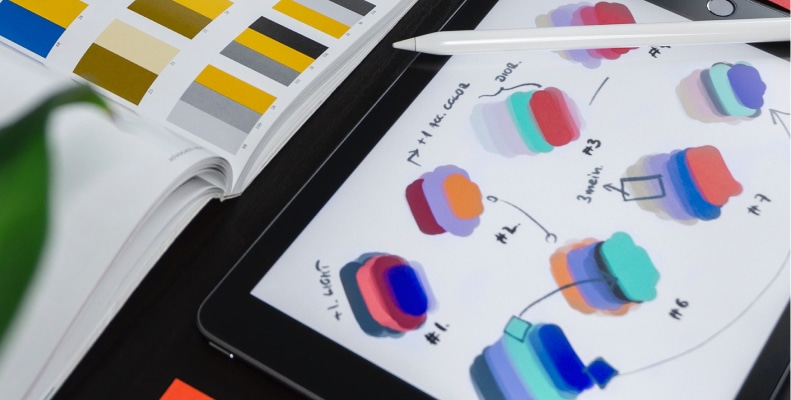Color serves as more than a visual guide in the world of design; it plays an important role in how we understand what we see. The concept of color psychology in design is not about just liking or disliking a color appeal, it delves into the emotional and psychological realms. Color psychology in design is a critical tool that, when used correctly, can communicate messages and evoke emotional responses. This subtle yet large influence can significantly impact website and graphic design practices.
Decoding the Science of Color Psychology in Design
Color psychology is the study of how different colors influence our emotions and decisions. Some colors might energize or excite us, whereas others might promote a sense of calm or relaxation. This knowledge is necessary in various fields, particularly in design, as it informs the strategic use of color to communicate and connect with users effectively.
In professional settings, especially in marketing and branding, understanding color psychology in design is crucial. It’s not just about selecting colors that “look good.” Instead, it’s about choosing colors that your audience feel good about, whether they know it or not. This aspect of design is grounded in color psychology, ensuring that the visual elements are aligned with the brand’s goals and messages.
By fully understanding and applying color psychology in design, brands can more effectively craft their identity, connect with their target audience, and stand out. This strategic approach to color selection is a big part of creating a coherent, impactful, and memorable brand presence.
Emotional Resonance Rooted in Colors
Emotions and colors are linked. Like how the color red is used in sale banners – it conveys urgency, driving people to make impulsive purchases. On the other hand, blue often brings a sense of stability, most used in websites and brands that wish to promote trust and professionalism. Every color can have a different meaning on it own. Sometimes this can change when you use a color together with other colors.
Understanding Colors and Their Psychological Impacts
Different colors come with their psychological baggage, influencing how they’re perceived and the emotions they stir:
- Red: Evokes a sense of urgency and heightened emotions, often used to draw attention to critical elements of a design. Because the color red often stands out, it’s perfect as a call to action.
- Blue: Inspires confidence, reliability, and relaxation, making it a favorite in corporate and professional settings.
- Green: With its strong associations with nature, green brings a sense of peace and denotes health, tranquility, and harmony.
- Yellow: Radiates optimism, energy, and happiness, though its high intensity can be overwhelming if not balanced correctly.
- Orange: This energetic color is a blend of red’s passion and yellow’s friendliness, often used to represent enthusiasm and excitement.
- Purple: This color suggests creativity and luxury, often used to prompt problem-solving or highlight innovation.
Implementing Color Strategies in Design
Implementing color psychology demands a strategic approach that resonates with both your brand’s identity and your audience. To capture the right colors, it is a good idea to create some color palettes. These color palettes should not only fit your brand’s voice, but should also speak to your demographic on a deeper, subconscious level. This is the start of a journey, transforming simple colors into a narrative for your brand’s story.
Define Your Brand’s Personality
Colors signify various attributes and can be used to communicate your brand’s values and personality. For instance, blue often conveys trust and dependability, making it suitable for financial companies, while green represents peace and health, commonly used in wellness brands. Using a monochromatic scheme can communicate a simple, harmonious message, while a complementary scheme is more visually striking, demanding attention. Each color scheme serves a unique purpose, directly affecting the audience’s mood and perception, essential for designs intended to influence or drive consumer behavior.

Understand Your Demographics
Perception of color can be influenced by factors such as age, culture, and personal preference. Research your target demographic’s psychological response to certain colors, and consider these insights in your design process to ensure your color choices resonate with your audience.
Selecting Your Palette
Beyond choosing a primary brand color, select secondary colors that complement it. These colors can have an effect on the visual communication. Use color theory to create a balanced and balanced brand color palette.
Consistency is Key
Implement your chosen colors across all aspects of your brand, including your logo, website, marketing materials, and packaging. Consistent use of color supports brand recall, helping your brand become recognizable and familiar. This should be laid out in a brand strategy.
Review and Revise
The market and your audience can evolve, and so should your branding. Regularly review your color psychology strategy and be open to changing things that don’t work. Make sure you know how the audience reacts, and if the right message gets through. This can happen via surveys or focus groups and can provide valuable insights into how your brand is perceived.
What to look out For in Color Psychology in Design
Color psychology plays a pivotal role in defining a brand’s identity. The colors a brand adopts are not just for visual appeal; they embody the brand’s message, ethos, and values. For instance, a company promoting sustainable products might lean towards green to represent environmental safety, reflecting their commitment to eco-friendly practices.
Influence of Color on Brand Perception
Color schemes directly influence how consumers perceive a brand. Fast-food restaurants often choose red as it triggers appetite and urgency, essential for impulse eating settings. Conversely, luxury brands select black or gold based on the colors’ association with elegance and exclusivity. Recognizing these color meanings helps businesses align with their audience’s psychological expectations.
Cultural Differences
Color psychology in design does not follow a ‘one-size-fits-all’ approach; what’s appealing or positive in one culture can have a completely different—or even negative—connotation in another. The color red for instance, represents warmth, passion, and excitement in Western contexts but is a traditional symbol of luck, happiness, and success in many Asian cultures.
Brands who want to resonate on an international scale must strategically use color psychology in design, making sure their visual identity reflects cultural norms. To make sure your color palette is understood across borders, follow these steps:
- Comprehensive Cultural Research: Before deciding on a color scheme, conduct thorough research into the cultural implications of certain colors in the regions where your brand will have a presence. This step is foundational in creating a design that communicates the intended message globally.
- Localized Design Strategy: Consider creating separate brand materials for different geographical areas. A localized strategy allows for cultural adaptation, ensuring that your brand’s visual elements are harmonious with local sensibilities.
- Consumer Feedback and Participation: Involve local voices in the decision-making process. Focus groups and surveys from target demographics in different countries can provide invaluable insights. This inclusive approach helps avoid unintentional cultural insensitivity.
Consistency in Color Leading to Brand Recognition
Brand recognition is fortified through consistent color use. Consistency evokes a sense of reliability and familiarity. It’s why recognizable brands like Coca-Cola and Facebook use specific color palettes, making them instantly identifiable worldwide. Maintaining color consistency across all platforms enhances brand recall, helping embed the brand image in consumers’ minds.
The Dynamics of Rebranding and Color Adaptation
Rebranding is a strategic overhaul of the brand identity, and color is central to this transformation. When a brand undergoes rebranding, a change in color scheme can signify a shift in company values, target audience, or positioning in the market. Analyzing competitors and understanding color psychology in design can inform successful rebranding, ensuring the new palette continues to align with consumer expectations and business aspirations.
The Role of Color Psychology in User Experience (UX) Design
In UX design, color is a functional component beyond aesthetics. High-contrast colors can improve text readability, while a soothing palette can enhance the overall user interaction by reducing eye strain. Knowing how to manipulate color schemes effectively ensures a balance between aesthetics and functionality, essential for maintaining user engagement and satisfaction.
Conclusion
In the kaleidoscopic world of design, the strategic use of color psychology is a cornerstone in building a brand’s visual identity. It transcends aesthetic, weaving itself into the emotional fabric of the consumer’s perception and interaction with a brand. This profound impact stretches from the initial design elements of a logo to the vast, nuanced fields of user experience and cultural sensitivity. Brands that harness the power of color psychology acknowledge its role as a silent salesman, narrating the brand’s story, ethos, and promise without words. As businesses evolve and markets shift, a firm grasp on the ever-significant role of color in design is paramount in maintaining relevance, resonance, and engagement in the consumer’s mind.
FAQ
How important is color psychology in design strategy?
Color psychology is vital in design, influencing consumer emotions, behaviors, and brand perception. It’s not just about aesthetics but effective, strategic communication.
Do color perceptions vary across cultures?
Yes, color meanings can change drastically across cultures, making understanding these nuances crucial for global brands to avoid misinterpretation.
What considerations should be made for color choices in international markets?
Brands need cultural research and possibly localized design strategies to ensure color palettes resonate appropriately worldwide.
How does color psychology affect rebranding efforts?
It’s key in rebranding, signaling changes in brand identity, values, or market position. The new color scheme must align with the brand’s future direction and audience perceptions.
Can color impact user experience (UX) design?
Absolutely, color in UX isn’t just about beauty; it enhances functionality, readability, and user interaction, balancing aesthetics with practicality.
